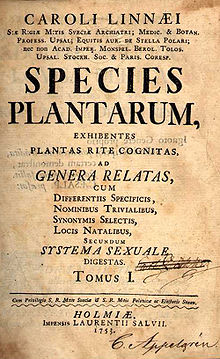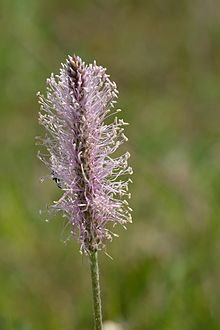植物の種
 初版の表紙 | |
| 著者 | カール・フォン・リンネ |
|---|---|
| 国 | スウェーデン |
| 言語 | ラテン語 |
| ジャンル | 植物学 |
| 出版日 | Laurentius Salvius (1 May 1753) |
| ページ数 | xi, 1200 + xxxi |
| OCLC | 186272535 |
『植物の種』(しょくぶつのしゅ、原題(ラテン語):"Species Plantarum")は、1753年にカール・フォン・リンネによって書かれた本で、当時知られていたすべての植物の種を属に分類してリストアップしたものである。二名法を一貫して適用した最初の著作であり、植物の命名法の原点となった。
出版
[編集]『植物の種』[注釈 1]は、1753年5月1日にLaurentius Salviusによってストックホルムで2巻に分けて出版された[注釈 2][2][3]。1762年から1763年にかけて第2版[2]、1764年に第3版が出版されたが、これは第2版の内容とほとんど変わらないものであった[4]。1778年にリンネが亡くなった後も、ベルリン植物園の園長だったカール・ルートヴィヒ・ヴィルデノウの指揮により、1800年に全4巻で構成される第5版が出版された[5]。
重要性
[編集]
『植物の種』は、二名法を大規模な生物群を対象に一貫して適用した植物学に関する著作の中では最初のものである(リンネが『自然の体系』第10版で初めて動物に同じ手法を適用したのは1758年のことである)。そのため、後世に登場するほとんどの植物の命名法の「出発点」となった(一部の非維管束植物とすべての菌類の命名法はまた別の文献を出発点としている[6])。『植物の種』以前は、植物種はPlantago folis ovato-lanceolatis pubescentibus, spica cylindrica, scapo tereti(「卵状披針形の葉、円筒形の穂、穂状茎を持つオオバコ」の意)[6]や、Nepeta floribus interrupte spicatis pedunculatis(「茎で途切れた穂に花を持つネペタ」の意[7]。日本語ではイヌハッカと呼ばれる植物のこと)といったように単語を複数繋げた長い名前で呼ばれていた。『植物の種』では、このような煩雑な名前を、1語の属名と1語の種小名からなる命名に変更し、上記の2例はそれぞれPlantago mediaとNepeta catariaとなった[6][7]。二名法の使用は、もともと牛が食べる植物についての学生プロジェクトにおいて、略語として考案されたものであった[8]。
リンネは、種小名の後にそれぞれの種の短い説明とシノニムを与えた。その記述は丁寧かつ簡潔で、小さな属では少ない単語で構成された。例えばカンゾウ属では3種(それぞれGlycyrrhiza echinata、Glycyrrhiza glabra、Glycyrrhiza hirsuta[注釈 3])が「leguminibus echinatis」「leguminibus glabris」「leguminibus hirsutis」として記述されていた[10]。
内容
[編集]『植物の種』には、当時リンネが知っていた何千もの植物種について記載されている。初版では、Acalypha australis(エノキグサ)からZygophyllum spinosumまで5,940種の植物名が紹介された[11]。リンネは序文において、1万以下の植物種が現存していると推定していたが[12]、2016年にキューガーデンが発表した『State of the World's Plants Report — 2016』によれば、顕花植物だけでもおよそ40万種あると考えられている[13]。
本書では、種は約1000の属に分類され、リンネの性分類体系に従って24の綱に分類された[14]。『植物の種』には属についての記述はなく、これらの記載は『植物の種』の初版と同時期に印刷された姉妹編"Genera Plantarum"(『植物の属』)第5版に記載されている[10]。リンネの性分類体系は、現在では共通の祖先を正確に反映したものではなく、人為的な分類体系であると認められている[14]が、その分類体系の単純さにより、専門家でなくても、花柄や雄しべなどの単純な数に基づいて、正しい分類を迅速にかつ簡単に見つけ出すことができた[2]。
脚注
[編集]注釈
[編集]- ^ 正式なタイトルは『Species plantarum, exhibentes plantas rite cognitas ad genera relatas, cum differentiis specificis, nominibus trivialibus, synonymis selectis, locis natalibus, secundum systema sexuale digestas』である。
- ^ 実際には第1巻は5月24日、第2巻は8月16日に出版されたが、実用上の観点から、各巻の発行日は恣意的に5月1日とされた[1]
- ^ 現在はG. glabraのシノニムとされている[9]
出典
[編集]![]() ウィキメディア・コモンズには、植物の種に関するメディアがあります。
ウィキメディア・コモンズには、植物の種に関するメディアがあります。
- ^ McNeill, J.; Barrie, F.R.; Buck, W.R.; Demoulin, V.; Greuter, W.; Hawksworth, D.L.; Herendeen, P.S.; Knapp, S. et al. (2012). International Code of Nomenclature for algae, fungi, and plants (Melbourne Code) adopted by the Eighteenth International Botanical Congress Melbourne, Australia, July 2011. Regnum Vegetabile 154. A.R.G. Gantner Verlag KG. ISBN 978-3-87429-425-6
- ^ a b c “Carolus Linnæus, Species Plantarum, Stockholm 1762–3”. Collection Highlight Summer 2007. University of Aberdeen (2007年). 30 April 2018時点のオリジナルよりアーカイブ。20 October 2013閲覧。
- ^ Winston, Judith (2012-04-20). Describing Species: Practical Taxonomic Procedure for Biologists. Columbia University Press. p. 35. ISBN 9780231506656 2018年4月30日閲覧。
- ^ Clive A. Stace (1991). “The development of plant taxonomy”. Plant Taxonomy and Biosystematics (2nd ed.). Cambridge University Press. pp. 17–64. ISBN 978-0-521-42785-2
- ^ V. N. Naik (1984). “A review of pre-Darwinian classification”. Taxonomy of Angiosperms. Tata McGraw-Hill. pp. 9–24. ISBN 9780074517888
- ^ a b c Katherine E. Cullen (2006). “Carl Linnaeus (1707–1778): binomial nomenclature system”. Biology: The People Behind the Science. Infobase Publishing. pp. 28–43. ISBN 978-0-8160-7221-7
- ^ a b Roger Spencer, Rob Cross & Peter Lumley (2007). “Latin names, the binomial system and plant classification”. Plant Names: a Guide to Botanical Nomenclature (3rd ed.). CSIRO Publishing. pp. 14–15. ISBN 9780643099456
- ^ Britannica Educational Publishing (2009). “Carolus Linnaeus”. The 100 Most Influential Scientists of All Time. Rosen Publishing Group. pp. 93–97. ISBN 9781615300402
- ^ “Glycyrrhiza hirsuta Linnaeus”. The Linnaean Plant Name Typification Project. Natural History Museum. 28 October 2013閲覧。
- ^ a b Duane Isely (2002). “Carl Linnaeus”. One Hundred and One Botanists. Purdue University Press. pp. 86–93. ISBN 9781557532831
- ^ Robert W. Kiger. “Index to Binomials Cited in the First Edition of Linnaeus' Species Plantarum”. Hunt Institute for Botanical Documentation. 2018年7月12日時点のオリジナルよりアーカイブ。2018年7月12日閲覧。
- ^ H. G. Bongard (1835). “Historical sketch of the progress of botany in Russia, from the time of Peter the Great to the present day; and on the part which the Academy has borne in the advancement of this science”. Companion to the Botanical Magazine 1: 177–186.
- ^ “Kew report makes new tally for number of world's plants”. BBC News. 28 October 2013閲覧。
- ^ a b Carnegie Library of Pittsburgh (2011). “Plant world”. The Handy Science Answer Book. Visible Ink Press. pp. 403–450. ISBN 9781578593637
参考文献
[編集]- Linnaeus, Carl (1753). Species Plantarum: exhibentes plantas rite cognitas, ad genera relatas, cum differentiis specificis, nominibus trivialibus, synonymis selectis, locis natalibus, secundum systema sexuale digestas (1st. ed.). Stockholm: Impensis Laurentii Salvii
- Species Plantarum, vol. 1, vol. 2 at Biodiversity Heritage Library facsimile
- Species Plantarum, vol. 1, vol. 2 at Botanicus
- Linnaeus, Carl (1763). Species Plantarum: exhibentes plantas rite cognitas, ad genera relatas, cum differentiis specificis, nominibus trivialibus, synonymis selectis, locis natalibus, secundum systema sexuale digestas (2nd. ed.). Stockholm: Impensis Laurentii Salvii
- Species Plantarum at Project Gutenberg I-III IV-V VI-X XI-XIII text
- Linnaeus Link Union Catalogue
